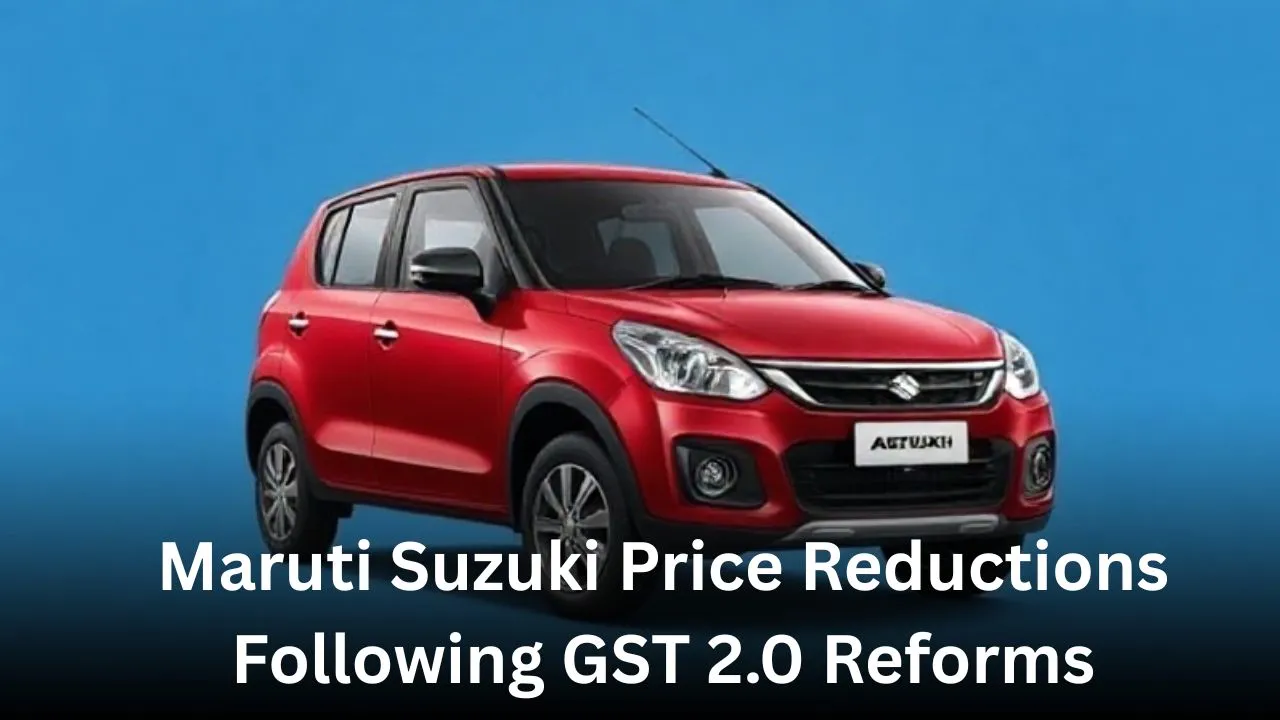Maruti Suzuki India Ltd., the largest carmaker in the country, has announced major price cuts across its vehicle lineup after the GST 2.0 reforms, effective September 22, 2025. The Goods and Services Tax (GST) Council lowered the tax rate on small cars (under 4 meters with petrol engines up to 1,200cc or diesel engines up to 1,500cc) from 28% to 18%. In response, Maruti Suzuki is passing on the entire benefit to consumers. This move, ahead of the festive season, aims to increase demand and make cars more affordable. Below is a detailed breakdown of the price cuts across key models and their implications for the market.
Price Reductions Across Maruti Suzuki Models
The price cuts, ranging from ₹46,400 to ₹1.29 lakh, affect a wide range of Maruti Suzuki’s models including hatchbacks, sedans, SUVs, and MPVs. Here’s a model-by-model breakdown of the new ex-showroom prices and reductions (based on available data):
S-Presso:
New Starting Price: ₹3,49,900
Reduction: Up to ₹1,29,600
Alto K10:
New Starting Price: ₹3,69,900
Reduction: Up to ₹1,07,600
Celerio:
New Starting Price: ₹4,69,900
Reduction: Up to ₹94,100
WagonR:
New Starting Price: ₹4,98,900
Reduction: Up to ₹79,600
Ignis:
New Starting Price: ₹5,35,100
Reduction: Up to ₹71,300
Swift:
New Starting Price: ₹5,78,900
Reduction: Up to ₹84,600
Baleno:
New Starting Price: ₹5,98,900
Reduction: Up to ₹86,100
Dzire:
New Starting Price: ₹6,25,600
Reduction: Up to ₹87,700
Tour S:
New Starting Price: ₹6,23,800
Reduction: Up to ₹67,200
Fronx:
New Starting Price: ₹6,84,900
Reduction: Up to ₹1,12,600
Brezza:
New Starting Price: ₹8,25,900
Reduction: Up to ₹1,12,700
Ertiga:
New Starting Price: ₹8,80,000
Reduction: Up to ₹46,400
Grand Vitara:
New Starting Price: ₹10,76,500
Reduction: Up to ₹1,07,000
Jimny:
New Starting Price: ₹12,31,500
Reduction: Not explicitly detailed, but significant cuts noted
Invicto:
Reduction: Noted as significant, but specific figures unavailable
Note: Prices are ex-showroom, Delhi, and may vary by variant and region. Buyers should check with dealerships for exact figures.
Context of GST 2.0 Reforms
The GST 2.0 reforms, announced on September 4, 2025, at the 56th GST Council meeting, simplified the tax system from four slabs (5%, 12%, 18%, 28%) to two (5% and 18%), with a new 40% slab for luxury goods and tobacco. Small cars, defined as vehicles under 4 meters with petrol engines up to 1,200cc or diesel engines up to 1,500cc, now face an 18% GST rate, down from 28%. Larger vehicles, including SUVs and luxury cars above these specifications, are taxed at 40%, reduced from 45–50%. Electric vehicles remain at 5%. This change aims to boost the auto industry and improve affordability, especially in the mass-market segment.
Market Impact and Strategic Timing
Maruti Suzuki’s choice to apply these price cuts coincides with the festive season, which is a peak time for car sales in India. The reductions are expected to:
Boost Demand: Lower prices make models like the Alto K10, Swift, and Brezza more accessible, especially for first-time buyers and fleet operators.
Strengthen Market Position: As competitors like Hyundai, Mahindra, and Tata Motors also reduce prices, Maruti Suzuki’s quick response reinforces its leading position in the passenger vehicle market.
Support Economic Growth: The auto industry anticipates a 6–7% growth rate in the next fiscal year, driven by greater affordability and consumer spending.
The temporary nature of these price cuts (valid until December 2025) creates urgency for buyers, likely increasing showroom traffic. Maruti Suzuki has also provided benefits to dealers and parts channels to stabilize the market.
Implications for Consumers
For buyers, the GST 2.0 reforms and Maruti Suzuki’s price cuts offer a unique chance:
Entry-Level Buyers: Models like the S-Presso and Alto K10, with cuts exceeding ₹1 lakh, are now within reach for budget-conscious consumers.
Mid-Segment Buyers: Popular models like the Swift, Dzire, and Brezza provide substantial savings, improving value for middle-class families.
Premium Segment: SUVs like the Grand Vitara and Jimny become more competitive, while larger vehicles are still subject to the 40% GST rate.
Consumers should act quickly, as the offer is time-limited, and verify variant-specific pricing with dealers.
Conclusion
Maruti Suzuki’s proactive response to the GST 2.0 reforms highlights its focus on affordability and market leadership. By lowering prices across its lineup, from the entry-level S-Presso to the premium Grand Vitara, the company aims to take advantage of festive season demand while making car ownership more accessible. The broader auto industry, including competitors, is likely to follow suit, resulting in a more vibrant and affordable market for Indian consumers. For the latest updates and precise pricing, visit Maruti Suzuki’s official website or authorized dealerships.
Sources: India TV News, Times of India, Business Standard, Hindustan Times, News9 Live, AutoVolte, Times Now, India Today







1 thought on “Maruti Suzuki Price Reductions Following GST 2.0 Reforms”